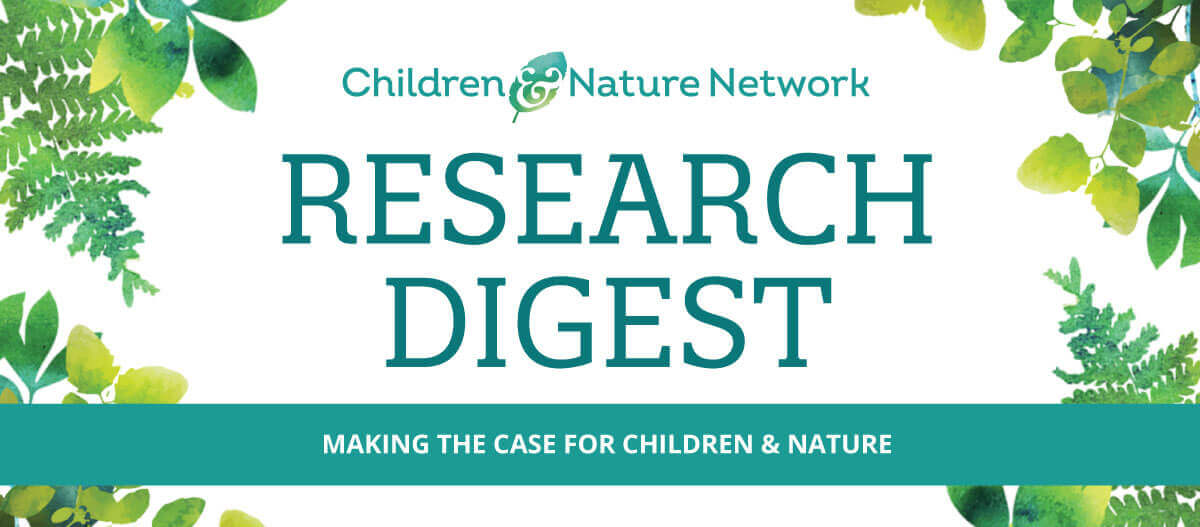Limit screen time and encourage green time
Research consistently demonstrates that to support children’s and adolescents’ healthy development, it is important to limit screen time while simultaneously encouraging more green time. The studies in this section reveal that children with higher screen times are more likely to demonstrate poorer mental health and well-being, neurodevelopment, and connection with nature. Conversely, children and adolescents who spend more time in nature consistently show stronger development across these same areas.
Screen time and green time are linked to psychological well-being in contrasting ways
This review of 186 studies addresses the association between screen time, green time, and psychological outcomes in children and adolescents. High levels of screen time were associated with unfavorable outcomes (depression, anxiety, stress, poor self-regulation), and green time was associated with favorable outcomes (positive mental health, cognitive functioning, academic achievement). Some evidence indicates that green time could buffer negative consequences of high screen time.
Oswald et al., 2020. Psychological impacts of “screen time” and “green time” for children and adolescents: A systematic scoping review.
Access Study
Promoting green time while reducing screen time can support children’s and adolescents’ mental health
A study conducted with 844 children and adolescents (age 5-19 years) in Switzerland revealed that higher screen times were significantly associated with increased mental health problems, while higher green times were significantly associated with reduced mental health problems. Females reported significantly lower levels of green time, but similar screen times, compared to males. The study highlights the importance of promoting time in nature while reducing screen time to support mental health.
Camerini, Albanese & Marciano, 2022. The impact of screen time and green time on mental health in children and adolescents during the COVID-19 pandemic.
Access Study
Green time moderates negative mental health effects of screen time for college students
Analysis of questionnaires completed by 372 college students in the U.S. examined relationships between screen time, time in nature and perceived mental health. Results linked screen time to increased anxiety, depression and stress in college students, while green time was associated with lower stress and depression. Findings also demonstrate that more time in nature may reduce mental health issues associated with screen time.
Deyo, Wallace & Kidwell, 2024. Screen time and mental health in college students: Time in nature as a protective factor.
Access Study
Suboptimal neurodevelopment outcomes linked to higher screen time among young children may be mitigated by outdoor play
Research in Japan examined screen time, outdoor play habits and subsequent neurodevelopmental outcomes of 885 children (age 2-4 years). Findings revealed that two-year-olds with more than one hour a day of screen time had significantly lower scores for communication and daily living skills at age four. However, for children with higher screen times, outdoor play lessened some of the adverse effects associated with screen use.
Sugiyama et al., 2023. Outdoor play as a mitigating factor in the association between screen time for young children and neurodevelopmental outcomes.
Access Study
Escalating screen time is having a negative influence on rural youths’ time outdoors and connectedness to nature
Over 500 sixth to eighth grade students in a rural area of the U.S. completed surveys that assessed time outdoors, screen time, and connection to nature (CTN). Outdoor time was significantly related to higher CTN and screen time to lower CTN. Overall, screen time increased and CTN decreased from sixth to eighth grade. Girls and African American youth were significantly more likely to have higher screen times and lower outdoor times and CTN.
Larson et al., 2019. Outdoor time, screen time, and connection to nature: Troubling trends among rural youth?
Access Study
For Canadian adolescents, as electronic media use increases, connection to nature decreases
A Canadian national study, which administered surveys to 24,000 youth (age 10-18) and interviewed 74 youth, found screen use may be linked to the decreasing importance of nature in the lives of young people, a theory referred to as the “displacement hypothesis.” Results showed that youth often prefer technology over being outdoors; screen technology tends to be addictive; and temporary disconnection from screen technology may lead to positive experiences with nature.
Michaelson et al., 2020. Electronic screen technology use and connection to nature in Canadian adolescents: A mixed methods study.
Access Study





